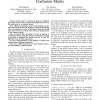Free Online Productivity Tools
i2Speak
i2Symbol
i2OCR
iTex2Img
iWeb2Print
iWeb2Shot
i2Type
iPdf2Split
iPdf2Merge
i2Bopomofo
i2Arabic
i2Style
i2Image
i2PDF
iLatex2Rtf
Sci2ools
110
Voted
ICTAI
2010
IEEE
2010
IEEE
Discountings of a Belief Function Using a Confusion Matrix
In this paper, we present an analysis of different approaches relative to the correction of belief functions based on the results given by a confusion matrix. Three different mechanisms based on discountings are detailed. These methods have the objective to assess the discounting rates to be assigned to a source of information. These discounting rates allow to correct raw data, based on learnt decisions given by the confusion matrix. These corrections differ according to the use of classical or contextual or distance using discountings. An illustrative example is presented to emphasize the interest and also to show the differences between these adjustments. We carry experimentations on real databases to analyze and interpret these adjustment approaches.
Related Content
| Added | 13 Feb 2011 |
| Updated | 13 Feb 2011 |
| Type | Journal |
| Year | 2010 |
| Where | ICTAI |
| Authors | Zied Elouedi, Eric Lefevre, David Mercier |
Comments (0)

